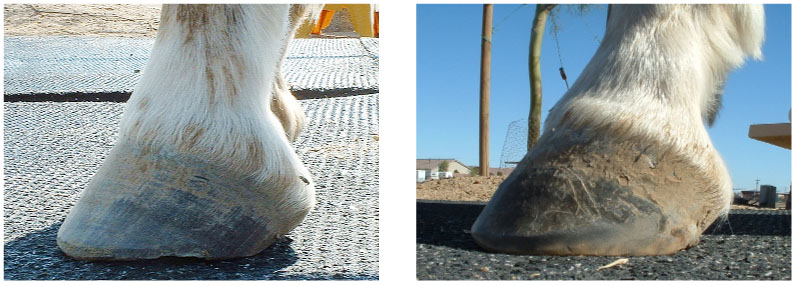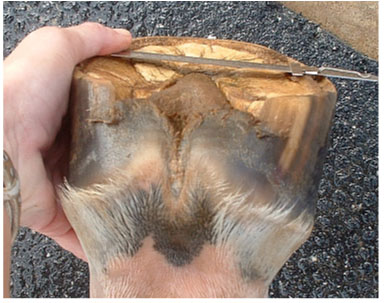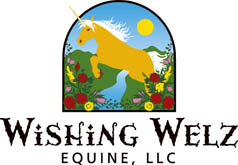
Trimming for Concavity/Vertical Toe Height
by Frances Guthrie ©2006
No, you can’t create a healthy, sound hoof by carving the
solar surface into a concaved form. Nor can toe height be created by trimming
the heels even shorter.
Yes, you can use trim techniques that will enhance natural hoof
form—such techniques are so successful that you might be tempted to say
you “trim for concavity!”
I want to jump right in and tell you about optimal toe length,
strong heels, thick soles, the importance of rounding the hoof walls, etc. But
first—let’s consider the importance of solar concavity, which is only
present when the hoof has vertical toe height. A hoof won’t have one without
the other! (Naturally, there are always exceptions, and this article is not
about extremely contracted hooves with full soles).
The Importance of Healthy Concavity
Simply explained, a hoof widens when it is weighted; as the walls
move outwards, the sole of a healthy, concaved hoof draws flat. (A little or
a lot—depending on the hoof, terrain, gait and impact). It is believed
that in the widening phase of hoof mechanism, the sole of a “flat-footed
horse,” is actually impacted by the coffin bone, with possible bruising
of the sensitive solar/frog corium. So concavity is important for comfortable
hoof mechanism, and the absorption of concussion.
When the toe wall of the hoof is too short vertically, the coffin
bone position relative to the limb, and the ground, is compromised. Therefore
angles, impact, shock absorption, hoof mechanism, circulation etc. are all affected
by lack of concavity and vertical toe height. When any area of the wall is too
short, the sole is often thin in that area, as well—which can be of little
concern, or develop into a serious pathology, with the coffin bone exposed.
The connection of the hoof capsule to the coffin bone and sensitive tissues and coriums, is commonly referred to as “coffin bone suspension.” It has been noticed that the coffin bone is quite high within the hoof capsule of the feral/wild horse, somewhat lower in the domestic horse, and the flat-footed, thin-soled horse’s coffin bone is very close to the terrain upon which the horse is walking! The white line connection is critical for soundness—and concavity is a great indicator.

Left: This horse could not gain vertical toe height; every time the heels were over-shortened to create a better hairline angle, the horse would overweight the toe due to heel pain, and thus continue a cycle of toe wear.
Right: Same foot, 8 months later. Adjusted trimming technique
helped this hoof gain substantial vertical toe height; hairline angle improved,
concavity developed, and horse was now sound. The cycle of toe wear was finally
broken.
The Trim Techniques
It’s pretty simple, really, and I don’t mean to sound
like a smart ass!
Keep the heels comfortable, back up the toes, and add a mustang
roll. The hooves will develop concavity, the soles will thicken, the toes will
increase in vertical height, the frontal hoof wall surface will grow in straight
and strong without dishing, and the horses will begin to walk over the rocks!
Maintain comfortable heels! Do trim to encourage natural, heel-first
or flat-footed landing. If the heels are strong and comfortable, the horse will
move confidently, hoof mechanism and healthy circulation will be optimal, and
the horse will no longer avoid weighting the heels. (Horses that are sensitive
in the heel area tend to shift their weight forward, and may wear the toe wall
excessively short—see photo example above).
Be cautious of trimming the heels, bars and quarters of the hoof
really short to obtain “correct” angles that will match the short
toe. A hoof trimmed in this way has a shallow profile, without adequate height
for concavity. The thin sole in the heel/bar triangle (seat of the corn) may
be sensitive on all but the most optimal of rehabilitation terrains.
This may also mean that you are unable to trim the bars lower
than the sole. In photos of wild horse hooves, the bars are usually quite short,
and passive to the hoof wall, but I have noticed that they do not appear to
be lower than the sole. Often the difference between heel comfort or not, is
simply a lighter bar trim for protection from the pebbles.
Watch those toes—and those flares. The hoof capsule is a
“cast” of the coffin bone, produced by the various coriums. If the
wall is permitted to flare, it pulls away from the coffin bone, reducing the
integrity of the white line connection. Long toes are forward flares, and they
pull the hoof capsule into an elongated form, stretching the sole. When the
sole is stretched, it is drawn flatter. FLAT = less concavity!
Trim to ensure the hoof wall grows out to the ground, parallel
to the coffin bone. This might mean rounding the wall more, or rasping a little
higher than last time; for some hooves, it may take a number of trims, but that’s
okay. But know that when the hoof wall grows in straight, without bulges, flares,
or dished areas, it will have a much better laminar attachment, increased vertical
toe height and concavity, too! You can measure the coronet/wall angle as described
by Dr. Strasser, the “healing angle” of the new wall growth that Jaime
Jackson refers to, or perhaps Bergy Bergeleen’s 1/3 measurement. They are
all similar!
And, round the hoof walls—yes, use some style of a Mustang
Roll. There is lots of rain where I live, and when I study the bottom edges
of a naturally worn hoof wall, it’s rounded, too—not unlike those
of the horses in drier terrains. I find that rounding the hoof wall is very
helpful to prevent flaring.
Don’t forget the sole—trim for concavity, by NOT trimming very much sole at all! Yes, really! Cultivate a strong, healthy sole that will flex on weight bearing, stabilize the hoof walls and protect the sensitive sole and frog from bruising.

Sound horses MUST have good concavity. This photo is an example
of how to evaluate your horse’s hoof concavity.
About the author: Former farrier and graduate of Dr Strasser’s certification course (2002), Frances incorporates the techniques of many popular barefoot trimming methods in her work. When she’s not consulting or trimming hooves, Frances is often found teaching natural horsemanship; her students learn to ride bareback and bitless—on barefoot horses, naturally!
This article was printed in issue 23 of The Horse's Hoof Magazine.
To order your subscription, please visit The
Horse's Hoof Store
©2006 by The Horse's Hoof. All rights reserved. No part of these publications may be reproduced by any means whatsoever without the written permission of the publisher and/or authors. The information contained within these articles is intended for educational purposes only, and not for diagnosing or medicinally prescribing in any way. Readers are cautioned to seek expert advice from a qualified health professional before pursuing any form of treatment on their animals. Opinions expressed herein are those of the authors and do not necessarily reflect those of the publisher.
The Horse's Hoof Website
Home - About Us - Horselover's
Corner - Articles - Barefoot
Performance - Barefoot Stories - Hoof
Gallery - Natural
Horse Care - EPSM
- The Horse's Hoof Clinics - Events
- Trimmers -
Pioneers - Friends
- Classified - Resources
- News - Links
To go shopping or subscribe to our magazine, please click here: The
Horse's Hoof Store
If you don't see a column to the left: To view the frames version of this site, please click here: TheHorsesHoof.com
The Horse's Hoof is a division of:

The Horse's Hoof
P.O. Box 1969
Queen Creek, AZ 85142
Phone (623) 935-1823
Message Phone: 1-623-935-1823
(Leave a message anytime.)
Email: editor @ TheHorsesHoof.com (delete spaces)